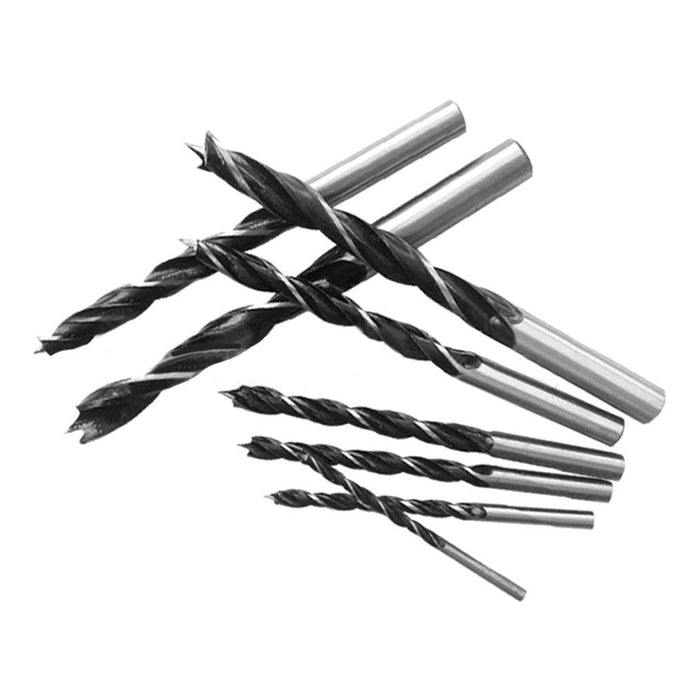
When it comes to drilling, the type of bit you use plays a crucial role in the quality of your work and the efficiency of the task at hand. Two of the most common types of drill bits are twist bits and brad point bits, each designed with specific tasks and materials in mind. Whether you're a DIY enthusiast or a seasoned professional, knowing when to choose one over the other can significantly impact the results of your project. But which is better? Is a twist bit really superior to a brad point bit, or does the brad point offer advantages that make it the better choice in certain situations? Let's break down the characteristics of both and see where each shines.
Twist drill bits are some of the most versatile and commonly used drill bits available. Their design is simple, with a spiral flute that helps remove material from the hole as it drills. The spiral also allows for faster chip removal, which is especially beneficial when drilling into harder materials like metal, plastic, or masonry. Twist bits are typically made from high-speed steel (HSS) or cobalt steel, materials that are highly durable and capable of handling the friction and heat generated during drilling. Because of their wide application range and availability in various sizes, twist drill bits are a staple in most toolboxes, suited for everything from drilling wood to metal to concrete.
Brad point drill bits - Findbuytool, on the other hand, are designed with precision in mind. Unlike twist bits, which have a pointed tip, brad point bits feature a sharp, center point that helps guide the bit to a precise location. The cutting edges around this point are specifically engineered to reduce splintering, making them an ideal choice for woodworking projects. The sharp center point ensures that the bit doesn't wander, providing excellent control, especially when starting a hole in a smooth surface like wood or plywood. The brad point's design is optimal for drilling clean, accurate holes with minimal mess, making it the preferred tool for tasks like doweling, cabinetmaking, and other fine woodworking applications.
So, is a twist bit better than a brad point bit? It depends largely on the material you're working with and the precision you require. When it comes to drilling into harder materials like metal, twist drill bits are the clear winner. The spiral flute design of twist bits allows them to handle the heat and pressure associated with drilling into tough substances like steel, aluminum, or plastic. These bits also work efficiently in masonry, where a brad point bit would struggle to maintain its sharpness or accuracy. The durability of the twist bit, especially when made from high-quality materials like cobalt, makes it suitable for a variety of tasks beyond wood, including heavy-duty applications.
However, when you're working with wood, the brad point bit has a distinct advantage. The sharp center point allows for precise placement, making it much easier to start a hole without the bit slipping or wandering. This is particularly important when working with fine, delicate wood or plywood, where any deviation in hole placement or splintering could ruin the finished product. The cutting edges of the brad point bit help to minimize splintering on both the entry and exit points of the hole, which is a common issue with twist bits when drilling through wood. If you're drilling small or medium-sized holes for dowels, screws, or decorative elements, the brad point bit is the superior choice for achieving clean, professional results.
In terms of versatility, twist bits again take the lead. A twist drill bit can be used for a wide variety of materials, including wood, metal, plastic, and even masonry (when equipped with the appropriate tip, such as a carbide-tipped version). While a brad point bit excels in woodworking, it is limited to softer materials and isn't designed to handle harder surfaces like metal or concrete. So, if you're tackling a project that requires drilling through multiple material types, a twist drill bit is likely to be more useful overall.
One of the key considerations when choosing between a twist bit and a brad point bit is the type of hole you need to create. If you need a smooth, accurate hole with clean edges and precise entry and exit points - particularly for joinery work, dowels, or cabinetry - the brad point bit is the best option. For general-purpose drilling where accuracy isn't as critical, and especially for materials like metal, plastic, or masonry, the twist bit is a more practical and efficient tool.
Another factor to consider is durability. Twist bits, especially those made from high-speed steel or cobalt, are built to withstand high heat and friction, making them more durable for heavy-duty tasks. Brad point bits, while excellent for clean woodworking, tend to wear down more quickly when used on harder materials, such as metal or thick plastic.
In terms of cost, twist drill bits are generally more affordable and widely available in various sets that cater to a broad range of drilling needs. Brad point bits, being more specialized, can be more expensive, but the quality and precision they offer for woodworking tasks often justify the investment.
Ultimately, the decision of whether a twist bit is better than a brad point bit comes down to the task at hand. For precision drilling in wood, the brad point bit is the superior choice, offering unmatched control and clean, sharp holes with minimal splintering. For versatility, durability, and general-purpose drilling in a variety of materials, the twist drill bit is the better option. For woodworkers, the brad point bit is an essential tool for achieving fine, professional results, while twist bits remain indispensable for a wider range of materials and projects. Understanding the strengths of each type of bit will help you select the right tool for your specific needs, ensuring that you can complete your tasks efficiently and effectively.
